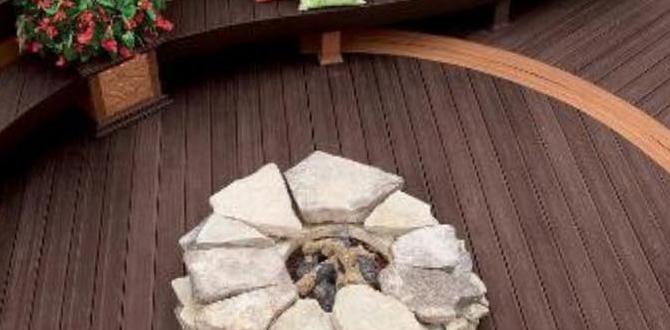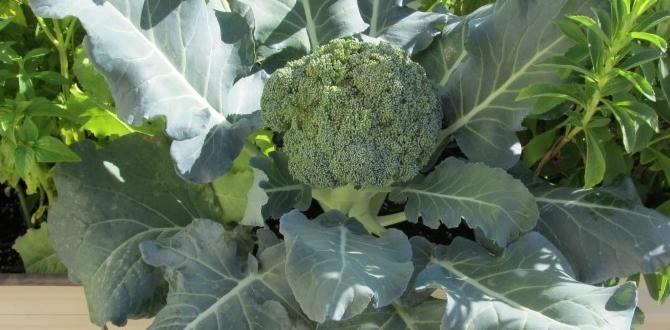Transform your garden into the ultimate entertainment hub with stunning and functional outdoor bars! This guide provides easy tips for choosing, building, and styling the perfect outdoor bar to suit your space and budget. Get ready to host unforgettable gatherings right in your own backyard.
Outdoor Bars For Gardens: Your Essential Guide
Dreaming of hosting backyard parties or enjoying a relaxing evening cocktail under the stars? An outdoor bar can make that dream a reality! Many beginner gardeners feel overwhelmed by the thought of creating a special outdoor space. They worry about complexity, cost, or whether it will even look good. But it doesn’t have to be complicated! With a little planning and some simple guidance, you can design and build an outdoor bar that perfectly complements your garden. We’ll walk you through every step, from choosing the right spot to adding those finishing touches. Get ready to impress your friends and family!
Why Add An Outdoor Bar To Your Garden?
An outdoor bar is more than just a place to serve drinks; it’s an extension of your home and a focal point for outdoor living. It creates a dedicated space for socializing, making entertaining a breeze. Imagine serving chilled beverages without constantly running inside, or having a convenient spot for snacks during a summer barbecue. It adds a touch of sophistication and fun to your garden, encouraging you and your guests to spend more time outdoors. Plus, it’s a fantastic way to personalize your garden space and make it truly your own.
Planning Your Perfect Outdoor Bar
Before you start building, a little planning goes a long way. Think about what you want your outdoor bar to do and how it will fit into your garden’s overall design.
1. Location, Location, Location!
Choosing the right spot is crucial. Consider these factors:
- Proximity to the House: Make it easy to carry supplies from the kitchen.
- View: Position it where you can enjoy the best garden views.
- Sun and Shade: Think about when you’ll use it most. Partial shade is often ideal for comfort.
- Level Ground: This makes construction and stability much easier.
- Electrical Needs: If you plan on lighting or a mini-fridge, be near an outdoor power source or plan for safe electrical installation.
- Drainage: Ensure the area doesn’t flood after rain.
2. Size and Scope
How large do you need your bar to be? Consider:
- Guest Count: How many people do you typically entertain?
- Functionality: Will it just be for drinks, or also for food prep and serving?
- Space Availability: Measure your chosen area to ensure a good fit.
Even a small corner can host a charming bar setup!
3. Style and Materials
What look are you going for? Rustic, modern, tropical? The materials you choose will define the style and durability.
- Wood: Popular choices include cedar, redwood, teak, or treated pine. They offer a natural, warm feel but require sealing and maintenance.
- Metal: Aluminum or stainless steel are durable and weather-resistant, often lending a modern look.
- Stone/Brick: These build sturdy, permanent structures that blend well with existing garden features.
- Composite Materials: A low-maintenance option that mimics wood or other natural materials.
Think about how the bar will complement your existing patio furniture, fencing, and landscaping.
4. Budget
Outdoor bars can range from simple DIY projects using reclaimed materials to elaborate custom builds. Set a realistic budget early on. This will help you make decisions about materials, features, and whether to DIY or hire help.
DIY Outdoor Bar Ideas For Every Skill Level
You don’t need to be a master carpenter to create a fantastic outdoor bar. Here are some ideas, from super simple to slightly more involved:
Beginner: The Pallet Bar
Pallets are widely available, often free, and can be transformed into surprisingly stylish bars. This is a fantastic project for a weekend!
Materials:
- Wooden pallets (3-4 usually suffice)
- Sandpaper
- Exterior paint or sealant
- Screws or nails
- Optional: Hinges, casters, treated plywood for the countertop
Steps:
- Source Pallets: Look for heat-treated (HT) pallets. Avoid chemically treated (MB) ones.
- Dismantle (Optional): If you want a smoother surface or unique design, carefully dismantle some pallets.
- Clean and Sand: Thoroughly clean the pallets and sand down any rough edges.
- Assemble the Structure: Stand two pallets upright to form the back and sides. Secure them together. You can attach a third pallet horizontally as a front support and shelf.
- Create the Countertop: Cut a piece of treated plywood to size to act as your bar top. Secure it firmly to the top of the back pallet. You might want to add a lip or edge for a more finished look.
- Finish: Paint or seal the entire structure with outdoor-appropriate finishes to protect it from the elements.
- Decorate: Add shelves inside, attach a small awning, or plant flowers around its base.
For more detailed instructions and inspiration, check out resources from DIY websites like Family Handyman.
Intermediate: The Cinder Block Bar
Cinder blocks are affordable, durable, and easy to work with. This creates a sturdy, modern-looking bar.
Materials:
- Cinder blocks
- Treated lumber planks (for shelves and countertop)
- Exterior wood sealant or paint
- Optional: Gravel for leveling, landscape fabric, reinforcing rods, concrete adhesive
Steps:
- Prepare the Ground: Level the chosen area. Lay down landscape fabric and a layer of gravel for drainage if desired.
- Lay the Base: Arrange cinder blocks to form the base structure of your bar. Ensure the holes are facing upwards. You can create single or double rows, depending on your desired height.
- Insert Shelves: Slide treated lumber planks into the block cavities to create shelves. You can secure them with concrete adhesive for extra stability.
- Add the Countertop: Place a wider, sturdier plank of wood on top, ideally resting across multiple blocks or securely adhered.
- Seal or Paint: Protect the wood with an exterior sealant or paint. You can also paint the cinder blocks for a more cohesive look.
Advanced: Custom Built-In Bar
If you’re comfortable with woodworking and construction, a custom built-in bar offers maximum flexibility and a high-end finish.
This usually involves framing with lumber (e.g., 2x4s), adding a durable countertop (like butcher block, granite, or concrete), and cladding the exterior with weather-resistant material (like treated wood, composite siding, or even stucco).
Key Considerations for Custom Builds:
- Foundation: Depending on your design, you might need a more substantial foundation.
- Plumbing/Electrical: If you’re including a sink or fridge, plan for these utilities.
- Materials: Invest in high-quality, weather-resistant materials for longevity.
- Professional Advice: For complex designs or utility hookups, consult a contractor or experienced builder.
The This Old House website offers excellent guides and tips for outdoor kitchen and bar construction.
Essential Features for Your Outdoor Bar
Once the basic structure is in place, consider these additions to make your bar functional and inviting.
1. The Countertop
This is where the magic happens! Your countertop needs to be durable, easy to clean, and look good.
- Treated Wood: Affordable and easy to work with, but needs regular sealing.
- Butcher Block: Offers a warm, inviting look but requires diligent sealing against moisture.
- Concrete: Extremely durable, customizable in color and finish, but can be heavy and requires proper sealing.
- Tile: Versatile in design, durable, and easy to clean. Ensure you use outdoor-rated tiles and grout.
- Stone (Granite, Quartz): The most durable and luxurious options, but also the most expensive and heavy.
Tip: Consider a slight overhang on the bar top to comfortably accommodate bar stools.
2. Seating
Comfortable seating is key for guests to linger and enjoy the space.
- Bar Stools: Choose weather-resistant materials like metal, recycled plastic, or treated wood. Consider backrests for extra comfort.
- Bench Seating: Built-in benches can save space and are perfect for casual gatherings.
- Height: Ensure stool height matches your bar height for comfortable use. Standard bar height is around 42 inches, and requires counter-height stools (around 30 inches seat height).
3. Storage
Keep your bar organized and functional with smart storage solutions.
- Shelves: Open shelves are great for displaying bottles, glassware, and decorations.
- Cabinets/Drawers: Enclosed storage keeps items protected from the elements and hidden away.
- Cooler/Ice Bucket: A built-in cooler or a designated spot for an ice bucket is essential for keeping drinks cold.
- Wine/Bottle Racks: Add dedicated racks for bottles and stemware.
4. Lighting
Extend your use of the bar into the evening with appropriate lighting.
- String Lights: Create a magical ambiance overhead.
- Task Lighting: Small LED lights under the bar top or on shelves can illuminate your workspace.
- Lanterns/Candles: For a more relaxed, intimate feel (use with caution).
5. Accessories
These little extras add personality and practicality.
- Sink: For ultimate convenience, consider adding a small outdoor sink.
- Mini-Fridge: If you have power, a compact outdoor fridge is a game-changer.
- Umbrella or Awning: Provide shade and shelter from light rain.
- Serving Trays, Ice Buckets, Cocktail Shakers: Stock your bar with essential tools.
- Plants: Incorporate potted plants around the bar to integrate it with your garden.
Bar Styles and Design Inspiration
Let your imagination run wild! Here are some popular styles to consider:
Rustic Charm
Think reclaimed wood, natural finishes, and perhaps a corrugated metal roof. This style blends seamlessly with a country garden or a more naturalistic landscape. Pair with wooden stools and simple decor.
Modern Minimalist
Clean lines, sleek materials like metal and composite decking, and a monochromatic color scheme. This suits contemporary homes and minimalist garden designs. Consider built-in storage and integrated lighting.
Tropical Retreat
Bamboo accents, vibrant colors, and perhaps a thatched roof or tiki bar elements. Perfect for creating a vacation vibe in your backyard. Serve with fun, colorful cocktails!
Cozy Corner Bar
For smaller spaces, think compact and functional. A simple shelf unit mounted to a wall, a small L-shaped bar made from a few repurposed crates, or a beautiful potting bench converted for drinks service.
Maintenance and Care
To ensure your outdoor bar lasts for years, regular maintenance is key.
- Cleaning: Wipe down surfaces regularly with mild soap and water.
- Sealing/Staining: For wooden bars, reapply sealant or stain annually, or as needed, to protect against UV rays and moisture.
- Covers: Consider investing in outdoor furniture covers to protect your bar during harsh weather or the off-season.
- Winterization: In colder climates, drain any plumbing, store cushions and sensitive accessories indoors, and consider covering or sheltering the structure.
Cost Breakdown: DIY vs. Professional Installation
Understanding the potential costs can help you decide the best route for your project.
| Feature/Service | DIY Estimated Cost | Professional Installation Estimated Cost | Notes |
|---|---|---|---|
| Simple Pallet Bar | $50 – $200 | $300 – $800 | Costs depend on pallet sourcing and finishes. |
| Cinder Block Bar | $100 – $400 | $500 – $1,200 | Includes blocks, wood, and basic hardware. |
| Custom Wood Bar (basic) | $300 – $1,000 | $1,500 – $5,000+ | Varies greatly with size, materials, and complexity. |
| Countertop Material (per linear foot) | DIY: $20 – $150 | Pro: $50 – $300+ | Wood vs. granite vs. concrete has huge cost differences. |
| Bar Stools (per stool) | $30 – $150 | $50 – $300+ | Material choice impacts price significantly. |
| Mini-Fridge | $100 – $300 | $150 – $500+ | Outdoor-rated appliances are typically more expensive. |
| Plumbing (sink installation) | N/A (requires expertise) | $500 – $2,000+ | Complex and may require permits. |
| Electrical (basic outlet) | N/A (requires expertise) | $200 – $600+ | Safety is paramount; professional installation is recommended. Consult local regulations like those from the National Electrical Code (NEC) for outdoor installations. |
These are rough estimates, and prices can vary based on your location, the specific materials you select, and the complexity of the design.
Frequently Asked Questions About Outdoor Bars
Q1: What is the best material for an outdoor bar countertop?
The best material depends on your budget and desired durability. For a blend of beauty and toughness, concrete, granite, or durable composite materials are excellent choices. For a more natural, softer look, treated hardwoods like teak or cedar can work, but require regular sealing.
Q2: Do I need special permission or permits to build an outdoor bar?
For most simple, freestanding outdoor bars, permits are not usually required. However, if your bar involves permanent structures, plumbing, or extensive electrical work, it’s wise to check with your local building department. They can inform you of any zoning ordinances or permit requirements.
Q3: How do I protect my outdoor bar from the weather?
Regular maintenance is key. For wooden bars, this means regular sealing or staining. For all types, consider using outdoor furniture covers during bad weather or the off-season. Ensure good drainage around the base to prevent moisture damage.
Q4: Can I build an outdoor bar on uneven ground?
While it’s best to build on level ground, you can adapt. You might need to level the area first using gravel and sand, or incorporate adjustable footings into your bar’s design. A concrete or cinder block bar can be more forgiving on slightly uneven surfaces if constructed carefully.
Q5: What kind of seating is best for an outdoor bar?
Weather-resistant bar stools are the most common. Look for materials like aluminum, wrought iron, treated wood, or durable outdoor-rated plastics. Consider comfort – backrests and armrests can make a big difference.
Q6: How much space do I need for an outdoor bar and seating?
This depends on the bar’s size and the number of stools. As a general rule, allow




